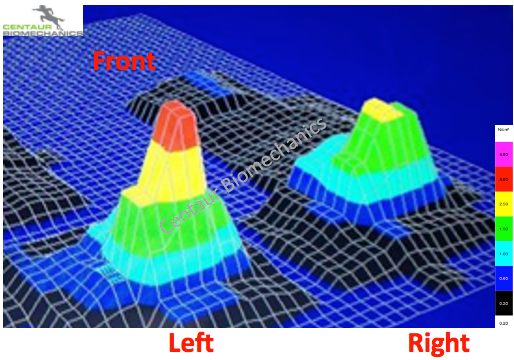
The rider needs to be able to withstand the propulsive forces generated by the horse during locomotion and adjust to the temporal and spatial movement patterns of the horse’s trunk. The coupled system of the horse and rider produces coordinated patterns which can be used to determine gait and riding styles. It is widely accepted that the rider’s position is influential for enhancing equine locomotion and performance. Riders attempt to be positioned on the horse symmetrically; however, this is sometimes challenging due to the rider’s skill level, functional asymmetries, perception, and pre-existing or historic injuries which the rider may have.
Understanding the interaction between the horse and rider (and saddle) has becoming better understood. Previously in an “off horse” study we have quantified rider perception (1). Thirty experienced riders, who were all right-handed, were asked to sit on a pressure mat which was positioned on a horizontal platform. Whilst sitting, the riders were asked to say when they “felt” evenly weighted on their seat bones, at which point five seconds worth of data was recorded which was then repeated three times resulting in fifteen seconds worth of data being used for analysis (1).
Despite riders saying they were “sitting equally”, from the pressure mat data, they had increased weight distributed beneath their left seat bone in comparison to the right (1) (image). Therefore, based on this study (and others), in this case riders’ perception of weight distribution appears to differ from objective measures. The next question is how does this translate to horse? – although riders may feel “straight” when riding, is there is a discrepancy between what is being perceived and what is objectively apparent? It is appreciated that in the current study riders were assessed using a static model; however, work is well underway quantifying seat pressures in a dynamic model (2021/2). It is speculated that the asymmetries seen in the “on horse” study will be similar to the findings from the “off-horse” study (1). Previous blogs have highlighted the effect that tack, and equipment have on quine locomotion. In the case of the rider, who is sitting on one seat bone more than the other, what effect will this have on the horse (and saddle)? As previously discussed, horses will develop a locomotor strategy to compensate to alleviate any discomfort and/or imbalance, in this case caused by the asymmetric rider.
Riders are athletes and all attempts should be made by the rider to optimise their position and physical fitness. Off-horse exercise, working with a human sports science team (physio, Pilates, therapist, biomechanist etc.) can be hugely beneficial. Improving rider’s dynamic stability “off-horse” will translate to dynamic stability and awareness “on-horse”, which will help optimise the interaction between the horse and rider.
Please like / follow our page for more blogs and please share to raise awareness.
Dr. Russell MacKechnie-Guire
Centaur Biomechanics
www.centaurbiomechanics.co.uk
#equineresearch #biomechanics #centaurbiomechanics #veterinarymedicine #equinephysiotherapy #equinetherapist #onlinecourses #onlineseminar
1. Guire R, Mathie H, Fisher M, Fisher D. Riders’ perception of symmetrical pressure on their ischial tuberosities and rein contact tension whilst sitting on a static object. Comparative Exercise Physiology. 2017;13(1):7-12.